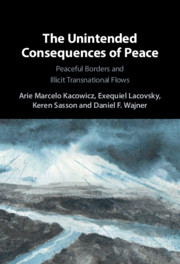Book contents
- The Unintended Consequences of Peace
- The Unintended Consequences of Peace
- Copyright page
- Dedication
- Contents
- Tables
- Preface
- Abbreviations
- 1 The Reality of Peaceful Borders and Illicit Transnational Flows
- 2 A Framework to Explain the Reality of Peaceful Borders and Illicit Transnational Flows
- 3 The Americas: A General View
- 4 The Americas: From the US-Canadian Border to the Tri-Border Area of South America
- 5 Europe: The Schengen Regime and the Western Balkan Borders
- 6 A Triangle of Peace in the Middle East: The Israeli–Egyptian and Israeli–Jordanian Borders
- 7 The Southern African Borders in the Postapartheid Era
- 8 ASEAN and the Southeast Asian Borders
- 9 Comparisons, Policy Recommendations, and Conclusions
- References
- Index
7 - The Southern African Borders in the Postapartheid Era
Published online by Cambridge University Press: 11 June 2021
- The Unintended Consequences of Peace
- The Unintended Consequences of Peace
- Copyright page
- Dedication
- Contents
- Tables
- Preface
- Abbreviations
- 1 The Reality of Peaceful Borders and Illicit Transnational Flows
- 2 A Framework to Explain the Reality of Peaceful Borders and Illicit Transnational Flows
- 3 The Americas: A General View
- 4 The Americas: From the US-Canadian Border to the Tri-Border Area of South America
- 5 Europe: The Schengen Regime and the Western Balkan Borders
- 6 A Triangle of Peace in the Middle East: The Israeli–Egyptian and Israeli–Jordanian Borders
- 7 The Southern African Borders in the Postapartheid Era
- 8 ASEAN and the Southeast Asian Borders
- 9 Comparisons, Policy Recommendations, and Conclusions
- References
- Index
Summary
In this chapter, we assess the links between the peaceful borders of the Southern African countries and the occurrence and proliferation of illicit transnational flows. Peace broke out in Southern Africa following the end of the regional and civil wars involving South Africa and its neighbors, and especially the domestic peaceful change that took place in South Africa in 1994, ending the apartheid regime and leading to the normalization of relations between South Africa and its neighbors. The threat of interstate warfare and violence in the SADC region has receded in the last twenty years, as the region has experienced a significant transition from war to stable peace. At the same time, in the aftermath of peace and integration, open and porous peaceful borders among the Southern African countries have enabled the occurrence and proliferation of both licit and illicit flows.
Keywords
- Type
- Chapter
- Information
- The Unintended Consequences of PeacePeaceful Borders and Illicit Transnational Flows, pp. 181 - 203Publisher: Cambridge University PressPrint publication year: 2021

